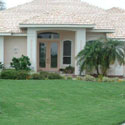Selecting a Florida-friendly Turfgrass
Different lawngrasses require different levels of maintenance. You should realistically assess how much time, money, and work you can put into maintaining your lawn before you establish it. During times of drought or water shortages, selecting the right turfgrass for your site becomes even more critical.
"Drought tolerance" refers to how well a turfgrass can survive extended dry periods. Drought tolerance is a quality you want to look for when establishing a lawn during a multi-year drought like the one Florida is currently facing. Other characteristics of your lawn site are also important, like how much shade the site gets, what its soil type and pH are, how its drainage functions, and what the climate of your area is like.
Consider, too, what you plan to use the lawn for. Is it primarily for aesthetic purposes, or will it receive heavy traffic from usage? Take all of these things into consideration when choosing a turfgrass. Visit Your Florida Lawn for more help with selection.
Drought-tolerant Grasses
The three most-used grasses for home lawns in Florida are St. Augustinegrass, bahiagrass, and centipedegrass. St. Augustinegrass, the most popular lawn grass in Florida, does not perform well during extended dry periods. Bahiagrass and centipedegrass, however, both have good drought tolerance, but centipedegrass is adapted to North Florida only. These low-maintenance lawn grasses require less water and fertilizer than other species, and thus less mowing and pest control. A low-maintenance lawn will generally look better during extended dry spells because it relies on less water and fertilizer in general, both of which are reduced during drought.
Irrigation
Deep-rooted bahiagrass and centipedegrass grow best in acidic, sandy soils that do not retain water. These grasses survive dry spells better and resist other kinds of stresses, such as traffic. The deep roots of these grasses make them good choices for establishing a lawn during an extended drought.
In most parts of Florida, irrigate by applying 1/2–3/4 inches of water at any given time. In very sandy soil, you may need to apply the 3/4-inch rate. In North Florida and the panhandle, where soils are heavier and have more clay, you may only need to use the 1/2-inch rate. In southeast Florida and the Keys, where the soil is shallow, you may only need to irrigate 1/4 inch to saturate it.
More lawns are damaged by over-watering than by any other cultural practice, so watering restrictions may not actually be as devastating as they seem. Water only when your lawn shows one of the three signs of wilt (lengthwise-folded blades, blue-gray color, or footprints remaining in grass).
Fertilization and Mowing
Bahiagrass and centipedegrass only need to be fertilized one or two times a year. For the correct fertilizer rates to use, read "Figuring Out Fertilizer for the Home Lawn." Both grasses should be mowed as needed, maintaining the highest recommended height for their respective species. For bahiagrass this is 3.5–4 inches and 1–2 inches for centipedegrass. Be aware that bahiagrass does tend to form tall seedheads during the growing season, which may be unsightly on a home lawn.
Pest Problems
All grasses have some pest problems, but bahiagrass and centipedegrass are generally less affected than other species. Sometimes pests can be managed by cultural practices such as fertilization, irrigation, and mowing. Other times, chemical controls may be required. Mole crickets are the major insect problem for bahiagrass, while ground pearls are the most prevalent insect pest of centipedegrass.
Sources

More Florida-Friendly Landscaping
- Florida-Friendly Landscapes help create a more sustainable Florida. Find out more.

